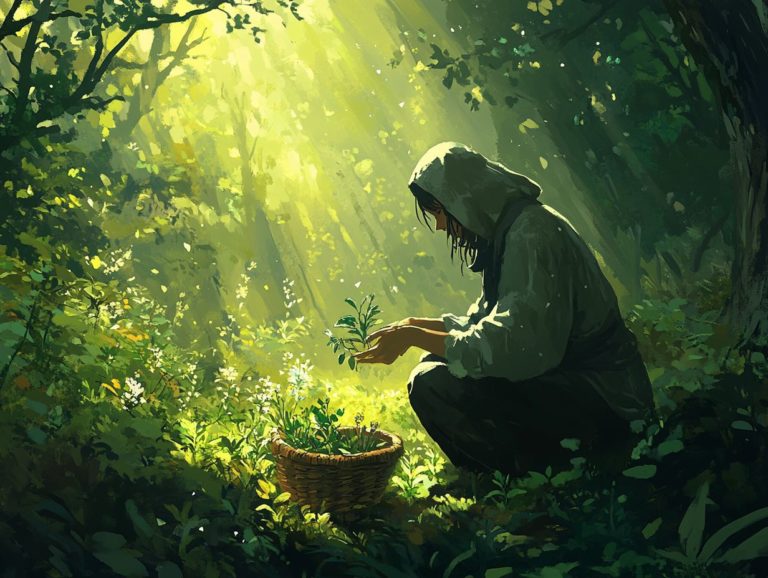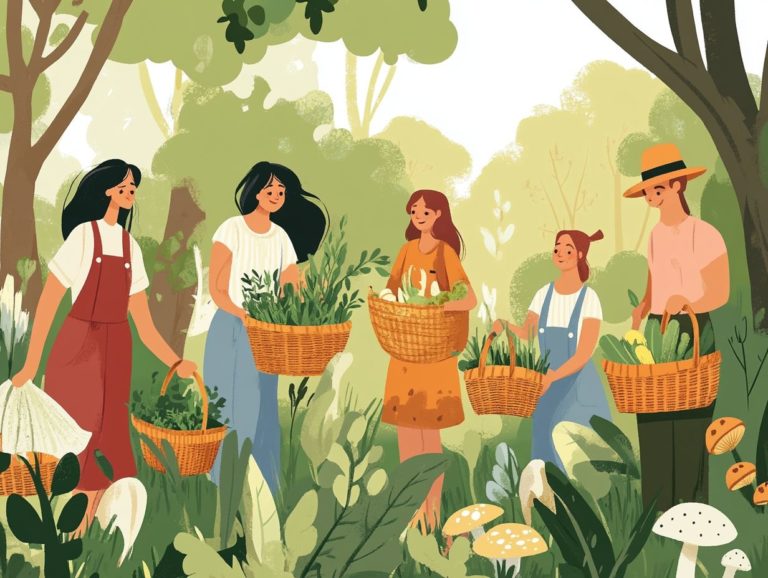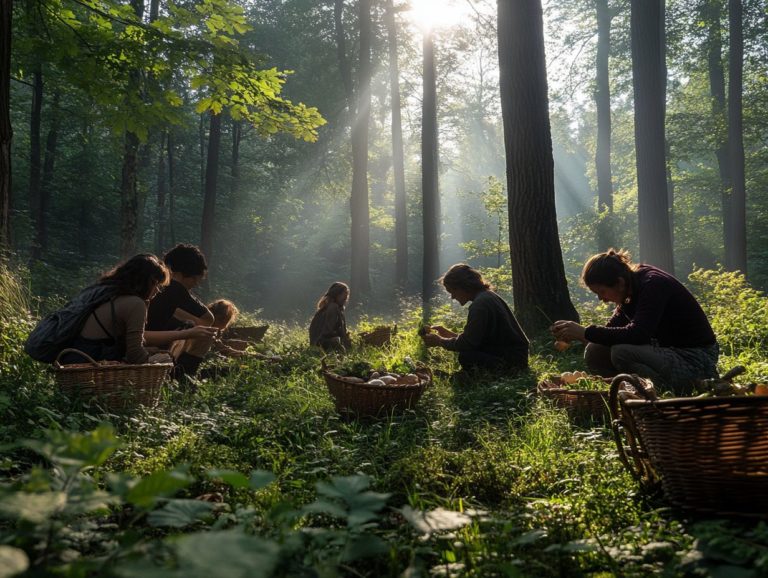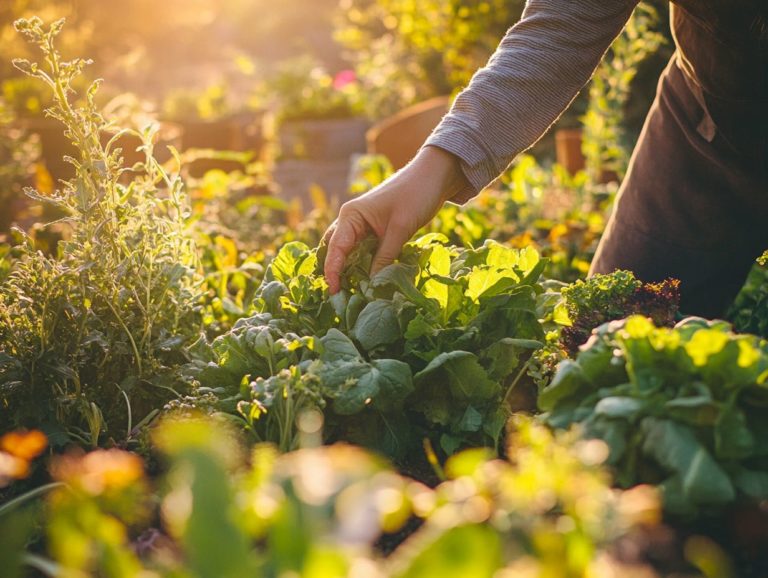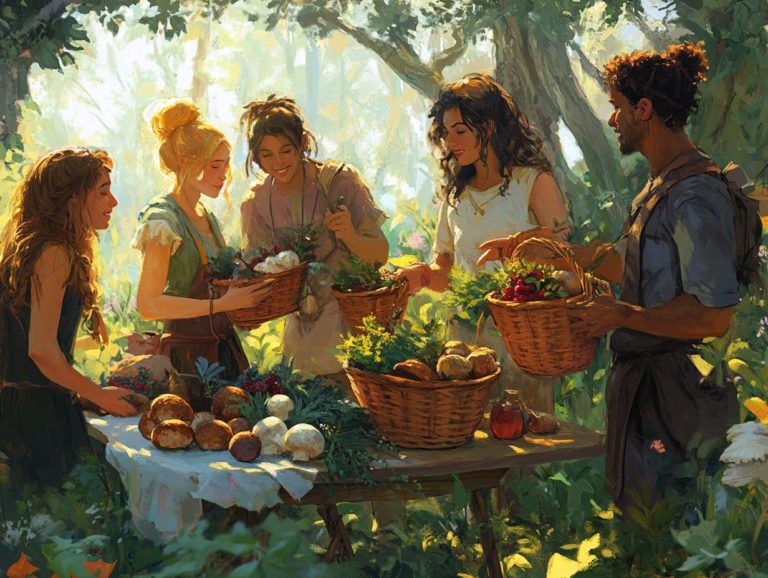Top 5 Edible Fungi for Sustainable Foraging
Foraging for edible fungi is not just a hobby; it s an epic adventure! It allows you to connect with the natural world in meaningful ways. You get to discover wild mushrooms and appreciate the variety nature offers.
This article covers five of the most sought-after mushrooms Morel, Chanterelle, Oyster, Hen of the Woods, and Porcini. Each mushroom has a unique flavor profile and valuable foraging tips, including safety considerations.
It discusses the benefits and risks of foraging and offers guidance on how to identify and preserve these delightful mushrooms. You ll also learn essential practices for sustainable foraging.
Whether you’re a seasoned forager or simply curious about fungi, including common mushrooms and the occasional encounter with poisonous varieties, you’ll find something to pique your interest and enhance your experience.
Contents
- Key Takeaways:
- 1. Morel Mushrooms
- 2. Chanterelle Mushrooms
- 3. Oyster Mushrooms
- 4. Hen of the Woods
- 5. Porcini Mushrooms
- What Is Sustainable Foraging and Why Is It Important?
- What Are the Benefits of Foraging for Edible Fungi?
- What Are the Risks of Foraging for Edible Fungi?
- How Can One Properly Identify Edible Fungi?
- What Are the Best Seasons for Foraging for Edible Fungi?
- How Can One Incorporate Foraged Fungi into Their Diet?
- What Are the Different Ways to Preserve Foraged Fungi?
- What Are the Environmental Impacts of Foraging for Edible Fungi?
- How Can One Ensure Sustainable Foraging Practices?
- What Are Some Additional Tips for Foraging for Edible Fungi?
- What Are Some Common Misconceptions About Foraging for Edible Fungi?
- Frequently Asked Questions
- What are the top 5 edible fungi for sustainable foraging?
- Why are these fungi considered sustainable foraging options?
- How can I identify these top 5 edible fungi in the wild?
- Are there any risks associated with foraging for these fungi?
- Can these fungi be found in different regions?
- What are some sustainable harvesting practices for foraging these fungi?
Key Takeaways:
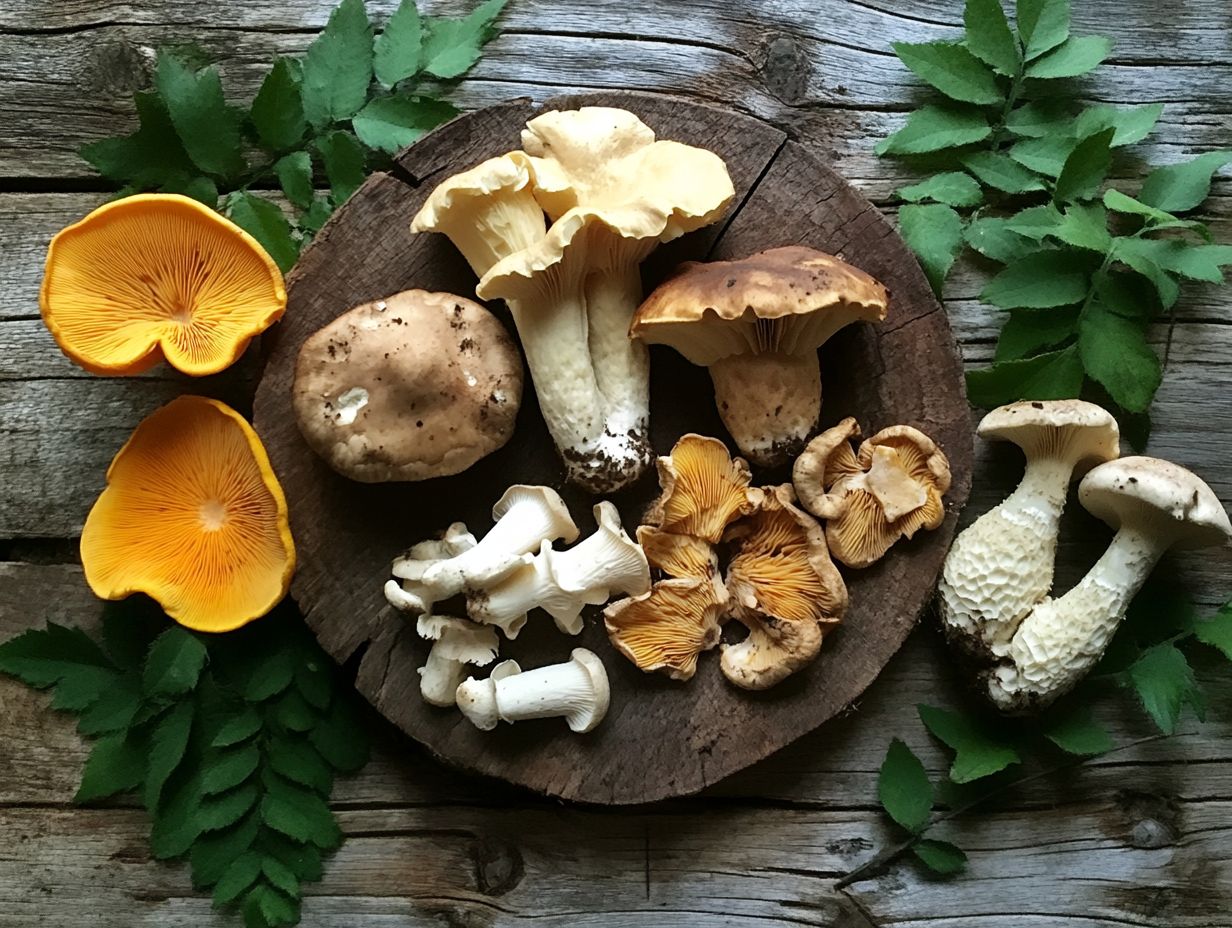
Morel and chanterelle mushrooms are delicious and popular for sustainable foraging. This practice connects you with nature and promotes biodiversity. Additionally, for those interested in foraging for nuts, exploring the top 5 wild nuts to forage in fall can enhance your foraging experience. To ensure sustainable foraging practices, it’s important to properly identify, preserve, and understand the environmental impacts of foraging for edible fungi.
1. Morel Mushrooms
Morel mushrooms, with their distinctive honeycomb appearance and rich, earthy flavor, are the cr me de la cr me of edible fungi. If you’re a mushroom picker, you ll find these gems particularly sought after in regions like France and Switzerland, especially after autumn rains that create perfect conditions for wild mushrooms.
These unique mushrooms thrive in moist, decaying woodlands and often cozy up near ash, elm, or tulip trees. Chefs love them, as they elevate risottos, pasta dishes, or even shine when saut ed in butter to bring out their sumptuous taste.
Foraging for morels isn t just a culinary quest; it s an adventure waiting to unfold. However, you must tread carefully getting the wrong type of mushroom can lead to serious toxicity concerns. Always use a reliable guide or consult local experts, especially in popular harvesting spots like the Midwest United States.
The prime time to gather these delicacies typically spans from late March to early June, depending on climate conditions. For others, like the Penny bun, the best time might be late summer to autumn.
2. Chanterelle Mushrooms
Chanterelle mushrooms, cherished for their delicate flavor and distinctive trumpet shape, are among the most sought-after edible fungi by foragers in both France and Switzerland. Autumn is the perfect time to hunt for them, as they flourish after the rains.
With their vibrant golden to orange hues, these mushrooms create a stunning contrast against the underbrush, making them an exhilarating discovery for adventurous chefs and nature enthusiasts alike. Their unique taste often described as fruity with a hint of pepper lifts a variety of dishes, from creamy risottos to savory saut s.
If you’re considering foraging for chanterelles, it s essential to understand the optimal conditions they require: moist, shaded areas under hardwood trees are ideal. However, proceed with caution; novice foragers should be aware of look-alikes, such as the toxic jack-o’-lantern mushroom.
Always consult a guide or expert before consuming any wild fungi to ensure a safe and enjoyable culinary experience. Ready to discover the wonders of mushrooms?
3. Oyster Mushrooms
Oyster mushrooms are hard to miss with their distinctive fan-shaped caps. They are a favorite among mushroom foragers due to their cooking options and delightful flavor. However, proper identification is essential to avoid mix-ups with similar-looking species.
These exquisite mushrooms thrive on decayed wood or in damp environments. They offer a delicate texture and a rich, earthy flavor that elevates a range of dishes, from stir-fries to creamy pasta sauces. When cooking with oyster mushrooms, saut them quickly to keep their tender structure intact, allowing their natural juices to shine.
If you re diving into foraging, familiarize yourself with the characteristics of edible varieties. Stay alert for look-alikes, like the toxic false gilled mushrooms. Always consult a knowledgeable guide or reliable resources to ensure your foraging adventure is safe and rewarding.
4. Hen of the Woods
Hen of the Woods, or Maitake, is a large, clustered mushroom that thrives at the base of trees, particularly oaks. Its earthy flavor and impressive health benefits make it a true treasure for foragers during the fall season.
This remarkable mushroom often presents a stunning rosette of overlapping, feathery caps. They can range from pale gray to rich brown, resembling the plumage of a chicken hence its whimsical name. The taste is both savory and slightly nutty, making it versatile for saut ing, roasting, or adding to soups.
Hen of the Woods also offers a plethora of health benefits, from boosting the immune system to potentially aiding in weight management. It is not just a delicious choice; it is a nutritious one as well.
When foraging for this delightful mushroom, look for moist woodland areas between late summer and early fall. Ensure you have a positive identification before consumption, as there are lookalikes that can pose risks.
5. Porcini Mushrooms
Porcini mushrooms, celebrated for their robust flavor and meaty texture, are a culinary treasure that chefs and home cooks eagerly seek, especially during the foraging season in Europe, with regions like France and Switzerland being prime hotspots.
Their rich, earthy notes and creamy consistency can elevate various dishes, transforming risottos, pasta, and cream sauces into extraordinary culinary experiences. Foraging for these gourmet mushrooms typically takes place from late summer to early autumn, ideally after refreshing rainfall that leaves the forest floor moist.
Safety is of utmost importance; exercise caution, as misidentifying them could lead to perilous encounters with mushrooms like the deadly Amanita. Common foraging missteps include overlooking the distinct characteristics that set porcini apart and harvesting them too early or late in the season, both of which can affect their flavor and texture.
What Is Sustainable Foraging and Why Is It Important?
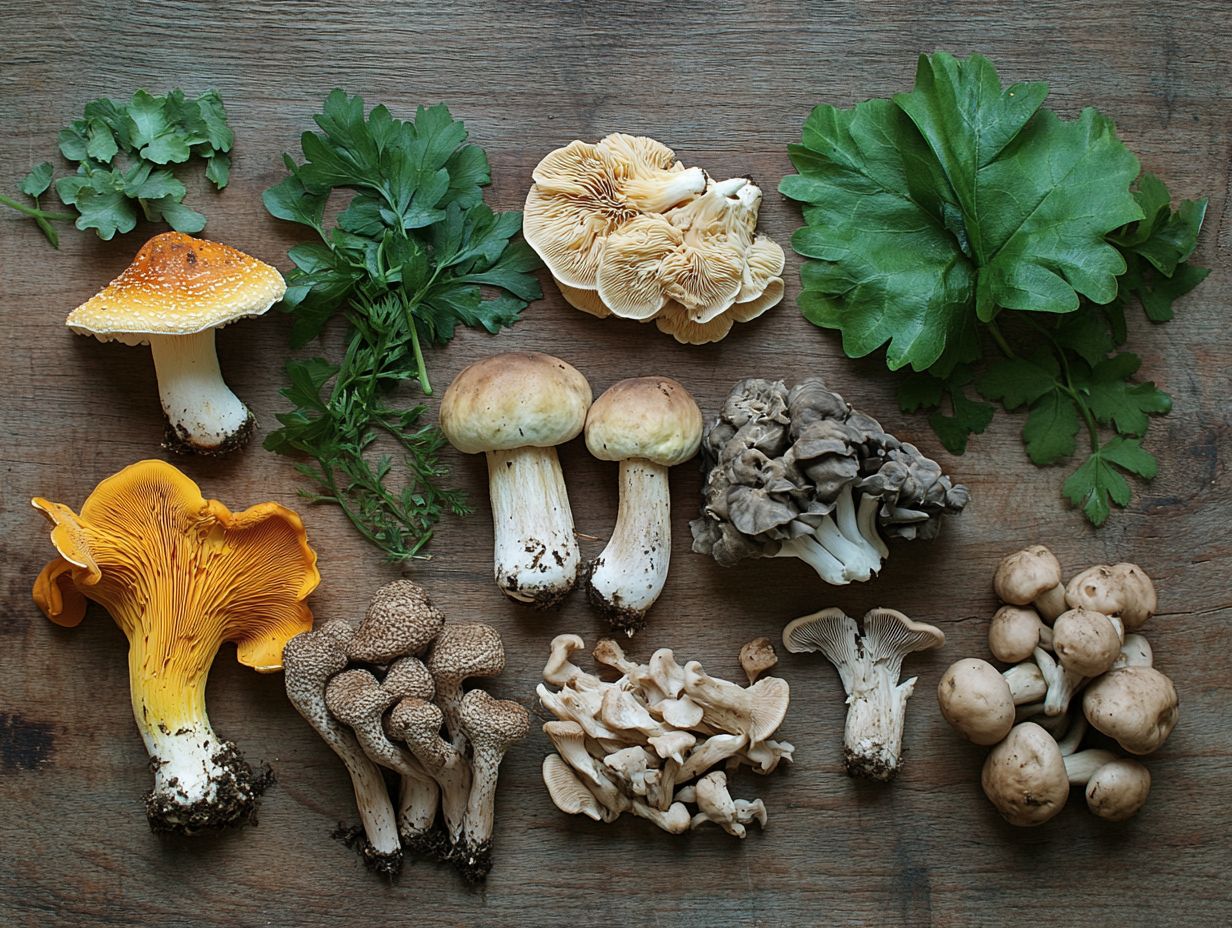
Sustainable foraging is all about harvesting wild mushrooms and other edible fungi in a way that keeps the ecological balance intact. To enhance your foraging experience, check out the top 5 foraging locations in your area this winter. This ensures that future generations can savor the rich biodiversity of mushrooms while minimizing the environmental footprint of foraging activities.
Understanding local ecosystems is key for you as an enthusiast. It allows you to gather mushrooms responsibly. By sticking to sustainable principles, you can prevent overharvesting, which can deplete species and disrupt the delicate balance of their habitats. This commitment is vital for promoting biodiversity, as mushrooms play significant roles in nutrient cycling, the natural process that allows nutrients to be reused in ecosystems, and offer habitats for various wildlife.
By raising awareness and educating others about responsible foraging practices, you can cultivate a deeper appreciation for mushroom habitats. This drives protection efforts that sustain these essential ecosystems for years to come!
Join in on the adventure of foraging!
What Are the Benefits of Foraging for Edible Fungi?
Foraging for edible fungi offers exciting benefits. You gain access to fresh, organic ingredients that enhance your cooking and connect you with nature, boosting your physical and mental well-being. By understanding wild edibles and sustainable harvesting, you can ensure these resources are available for future generations.
Engaging in this outdoor pursuit nurtures your sense of adventure and encourages you to embrace a healthier lifestyle. Wild mushrooms are not just a delightful find; they re also loaded with essential nutrients, including antioxidants, vitamins, and minerals that can boost your overall health.
Foraging also brings people together, inviting you to bond with friends and family over shared experiences in the woods as you learn about the ecosystem together. This practice sparks environmental awareness, inspiring a collective responsibility for sustainable resource management and promoting biodiversity, ultimately leading to a more informed and connected community.
What Are the Risks of Foraging for Edible Fungi?
Foraging for edible fungi can be incredibly rewarding, but it also comes with risks. Misidentifying poisonous mushrooms, such as Amanita phalloides, can lead to severe health consequences. This highlights the critical need for proper mushroom identification and knowledge, especially when foraging in regions like France and Switzerland.
The dangers become particularly evident with species like the death cap and Amanita phalloides, which can easily be confused with harmless varieties. These mushrooms harbor potent toxins that can result in liver failure and, in extreme cases, even death if consumed.
To navigate these risks, it’s essential to prioritize education and familiarize yourself with credible field guides. Don’t wait! Join a foraging class today to enhance your skills and safety. Hands-on learning is invaluable and will help you confidently differentiate between safe and hazardous species. Remember, knowledge is truly your best defense against the perils of misidentification.
How Can One Properly Identify Edible Fungi?
Properly identifying edible fungi is essential for safe foraging. It requires a keen understanding of the distinctive characteristics of various mushrooms think color, shape, habitat, and spore prints to differentiate them from their poisonous relatives.
As you explore the fascinating world of the study of mushrooms, make sure to utilize various visual guides. These resources can provide illustrative comparisons that highlight key features, making identification clearer. Different types of mushrooms boast unique patterns and colors, and knowing their typical growing environments can significantly boost your identification accuracy.
Consulting reliable resources like field guides or seasoned foragers is invaluable; their insights can help you avoid potentially harmful mistakes. Engaging with communities, both online and offline, allows you to share experiences and gather advice, transforming your pursuit of safe foraging into an informative and enjoyable adventure.
What Are the Best Seasons for Foraging for Edible Fungi?
The finest seasons for foraging edible fungi, especially in picturesque regions like France and Switzerland, align perfectly with the autumn rains. This is when conditions become just right for mushroom growth, presenting a splendid variety of species waiting for you to discover.
But the bounty doesn’t end there; spring showcases the delicate morels, cherished for their distinctive flavor, while the warmer summer months unveil an array of boletes and chanterelles, flourishing in sun-drenched woodlands.
Weather conditions are crucial for the success of your foraging adventures. Consistent rainfall and mild temperatures during these seasons create the ideal microclimate for mushrooms to thrive. The fluctuating humidity levels throughout the year also dictate which species emerge, transforming each season into an exciting surprise for those eager to delve into the vibrant world of fungi.
How Can One Incorporate Foraged Fungi into Their Diet?
Incorporating foraged fungi into your diet can elevate your meals with unique flavors and nutritional benefits. Whether you re using them in traditional recipes or crafting modern culinary masterpieces, it s a delightful way to celebrate the season’s bounty.
These enchanting ingredients can be saut ed, roasted, or featured in risottos and soups. They provide incredible versatility in the kitchen. If you re keen on preserving the essence of these wild treasures, techniques like drying or pickling can extend their shelf life while maintaining their rich flavors.
Proper storage is crucial when it comes to foraged mushrooms. Keeping them in a paper bag in the refrigerator helps prevent moisture buildup and keeps them fresh for days. Don’t hesitate to experiment with different pairings. Herbs and spices can further elevate your dish and showcase the mushrooms distinctive characteristics, transforming your culinary experience.
What Are the Different Ways to Preserve Foraged Fungi?
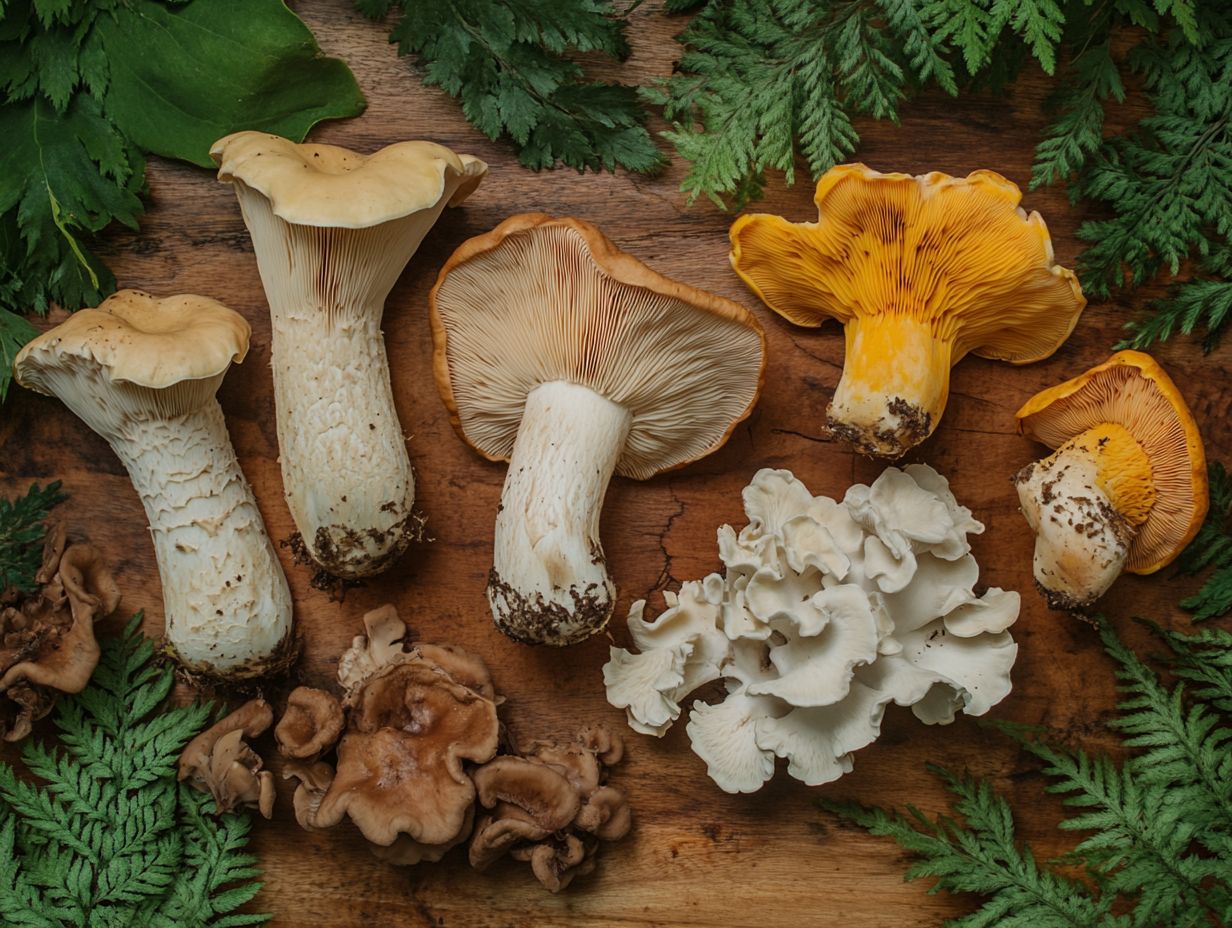
There are several effective methods for you to preserve foraged fungi. This allows mushroom enthusiasts like yourself to enjoy the harvest long after the foraging season wraps up. Techniques such as drying, freezing, and pickling can be your go-to strategies.
These methods not only extend the shelf life of mushrooms but also keep their rich flavors and essential nutrients intact. Drying, for instance, involves removing moisture to ward off spoilage, making it one of the most favored choices for long-term storage.
Freezing helps maintain texture and taste, allowing you to incorporate them into various dishes effortlessly. Pickling introduces a delightful acidity that can elevate the overall flavor profile, transforming your mushrooms into tantalizing snacks or side dishes.
Each of these methods comes with its own benefits and best practices. They ensure that the unique taste and health advantages of mushrooms are preserved for months, if not years.
What Are the Environmental Impacts of Foraging for Edible Fungi?
Foraging for edible fungi has effects on the environment, both positive and negative. These impacts largely depend on the sustainable practices you choose to employ. Understanding the ecological balance is essential when harvesting wild mushrooms.
By engaging in responsible foraging, you can make a real difference in habitat preservation. This ensures that local ecosystems flourish and maintain their diversity. This practice deepens your connection to nature and fosters biodiversity by encouraging the growth of various fungal species.
However, it s crucial to exercise caution. Overharvesting can deplete these invaluable resources and jeopardize their populations. Thus, embracing sustainable practices such as adhering to foraging guidelines and only taking what you truly need becomes imperative for preserving this delicate ecological balance for generations to come.
How Can One Ensure Sustainable Foraging Practices?
Ensuring sustainable foraging practices requires you to educate yourself about the local ecosystem, respect nature, and follow guidelines that protect both the mushrooms and their habitats. This approach allows you to enjoy wild fungi for years to come.
By embracing these mindful habits, you cultivate a deeper connection with nature and promote the health of diverse fungal species. It’s essential to take only what you need, minimizing your impact on the environment and ensuring that others can also partake in the bounty.
Understanding local regulations not only helps you forage responsibly but also supports conservation efforts aimed at preserving native ecosystems. Engaging with local foraging communities can provide you with invaluable knowledge, shared experiences, and collective efforts to maintain healthy mushroom populations for future enthusiasts.
What Are Some Additional Tips for Foraging for Edible Fungi?
When you venture into foraging for edible fungi, having some helpful tips can make your foraging experience better. Consider going with an expert, consulting a reliable field guide, and familiarizing yourself with the local laws regarding mushroom collection.
Once you’ve gathered your treasures, understanding the nuances of safe handling and storage is paramount. Donning gloves can help prevent contamination, and storing mushrooms in breathable containers will extend their freshness.
As a new forager, you might also want to explore joining local foraging groups or online communities. These platforms offer shared experiences and resources that can significantly enhance your learning curve. Engaging with seasoned foragers allows you to gain invaluable insights into identifying safe mushrooms, along with practical tips for cooking and preparing them safely.
This knowledge creates a supportive community where you can confidently refine your skills.
What Are Some Common Misconceptions About Foraging for Edible Fungi?
Common misconceptions about foraging for edible fungi can lead you down a path of confusion and even peril. For instance, many believe that all mushrooms are safe to eat if cooked or that specific wild varieties can be easily identified without proper knowledge.
You may assume that because a mushroom graces the shelves of your grocery store or bears a resemblance to a known edible variety, it must be safe to consume. However, this couldn’t be further from the truth. Take the notorious Death Cap mushroom, for example; it often mimics the delicious Champignon, but mistaking one for the other could have fatal consequences.
This is why it’s crucial to emphasize the importance of education through reliable resources and expert guidance. Ensuring that you have a solid understanding of what to forage safely can make all the difference. By conducting thorough research, you’ll learn to distinguish between the edible and the toxic, arming yourself with the skills needed to navigate the wild with confidence. Don’t risk your safety learn the facts before you forage.
Frequently Asked Questions
What are the top 5 edible fungi for sustainable foraging?
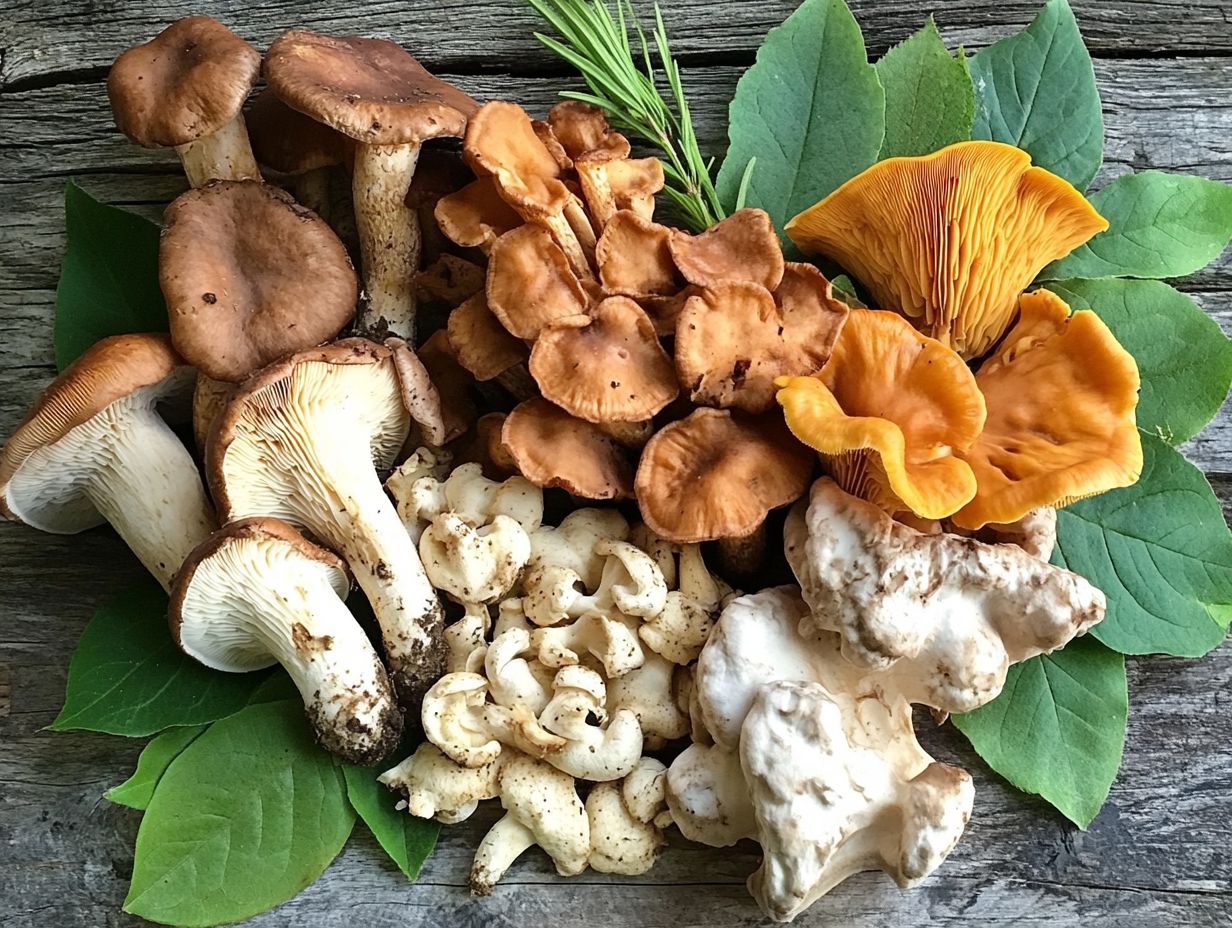
The top 5 edible fungi for sustainable foraging are morel mushrooms, chanterelle mushrooms, oyster mushrooms, porcini mushrooms, and hen of the woods mushrooms.
Why are these fungi considered sustainable foraging options?
These fungi are considered sustainable foraging options because they are abundant in the wild, can be easily identified and harvested, and have a low impact on their surrounding ecosystems. For more information, check out these top tips for successful foraging.
How can I identify these top 5 edible fungi in the wild?
Ready to find these delicious fungi in the wild? Here s how! Each of these fungi has distinct physical characteristics that make them easily identifiable. For example, Laetiporus sulphureus (commonly known as chicken of the woods) features bright orange to yellow caps, while Laccaria amethystina (the amethyst deceiver) is known for its striking purple color. It is important to do thorough research and consult with an expert before foraging to ensure proper identification.
Are there any risks associated with foraging for these fungi?
While these fungi are generally safe to eat, it is important to be cautious and avoid any fungi that you are unsure of. Some can be toxic if consumed and may have similar physical characteristics to edible ones.
Can these fungi be found in different regions?
Yes, these fungi can be found in various regions around the world. However, it’s important to research the specific areas and seasons where they are most likely to be found for optimal foraging success.
What are some sustainable harvesting practices for foraging these fungi?
It is important to only take what you need and to leave some behind for future foragers and for the fungi to continue growing.

